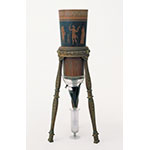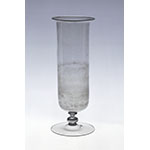The condensation hygrometer was probably invented by Grand Duke Ferdinand II de' Medici. The Cimento academicians built many copies in various shapes, operating designs, and materials. The truncated cone in the lower part was lined with glass, to make it impermeable, and filled with "snow or ice very finely ground." The humidity in the air, in contact with the iced glass, condensed, causing the formation of water drops that descended toward the apex of the cone, gathering in the graduated glass below. The higher the atmospheric humidity, the greater the condensation. The quantity of water gathered in the glass over a certain period of time was therefore a relative measure of the humidity. This large instrument corresponds in every particular to the drawing in the Saggi di naturali esperienze fatte nell'Accademia del Cimento [Examples of natural experiments made in the Accademia del Cimento] (Florence, 1667).
The glass dates from the seventeenth century. It has a cylindrical body with a flared rim, a small stem with an annular knop, and a round foot. Its design derives from the Venetian style of reliquary illustrated in the manuscripts of Giovanni Maggi's Bichierografia (1604).











